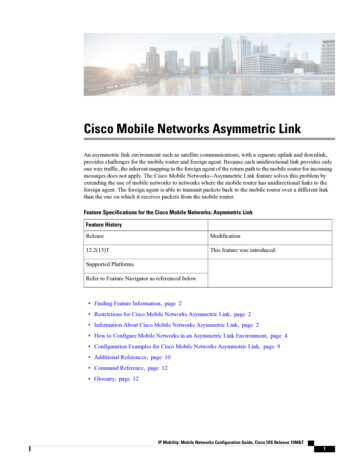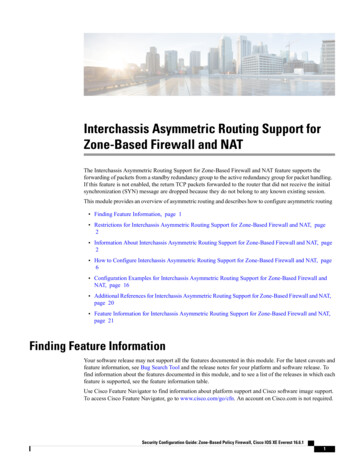
Transcription
Cisco Mobile Networks Asymmetric LinkAn asymmetric link environment such as satellite communications, with a separate uplink and downlink,provides challenges for the mobile router and foreign agent. Because each unidirectional link provides onlyone way traffic, the inherent mapping in the foreign agent of the return path to the mobile router for incomingmessages does not apply. The Cisco Mobile Networks--Asymmetric Link feature solves this problem byextending the use of mobile networks to networks where the mobile router has unidirectional links to theforeign agent. The foreign agent is able to transmit packets back to the mobile router over a different linkthan the one on which it receives packets from the mobile router.Feature Specifications for the Cisco Mobile Networks: Asymmetric LinkFeature HistoryReleaseModification12.2(13)TThis feature was introduced.Supported PlatformsRefer to Feature Navigator as referenced below. Finding Feature Information, page 2 Restrictions for Cisco Mobile Networks Asymmetric Link, page 2 Information About Cisco Mobile Networks Asymmetric Link, page 2 How to Configure Mobile Networks in an Asymmetric Link Environment, page 4 Configuration Examples for Cisco Mobile Networks Asymmetric Link, page 9 Additional References, page 10 Command Reference, page 12 Glossary, page 12IP Mobility: Mobile Networks Configuration Guide, Cisco IOS Release 15M&T1
Cisco Mobile Networks Asymmetric LinkFinding Feature InformationFinding Feature InformationYour software release may not support all the features documented in this module. For the latest caveats andfeature information, see Bug Search Tool and the release notes for your platform and software release. Tofind information about the features documented in this module, and to see a list of the releases in which eachfeature is supported, see the feature information table.Use Cisco Feature Navigator to find information about platform support and Cisco software image support.To access Cisco Feature Navigator, go to www.cisco.com/go/cfn. An account on Cisco.com is not required.Restrictions for Cisco Mobile Networks Asymmetric LinkThis feature can be used only on serial interfaces.Information About Cisco Mobile Networks Asymmetric LinkUnidirectional Routing in Cisco Mobile NetworksWith unidirectional routing, registration requests from the mobile router travel a slightly different route thanin bidirectional routing. The mobile router uses different interfaces to transmit and receive. Advertisementsare received on the mobile router interface that is connected to the uplink equipment. This interface is configuredto be receive-only (transmit-interface command) and another interface connected to the downlink traffic isconfigured to be transmit-only. When the mobile router receives an advertisement from the foreign agent onthe uplink, it takes the care-of address advertised by that foreign agent to use in the registration request.However, the mobile router has been configured to send traffic to a downlink router even though it hearsadvertisements on the interface connected to the uplink equipment. The registration request is sent out themobile router’s downlink interface to the care-of address given in the the foreign agent’s uplink interface.The downlink router routes the registration request using normal routing to the foreign agent. When the foreignagent receives the registration request, it looks up the care-of address. If the care-of address is associated withan asymmetric interface, the foreign agent treats the mobile router as a visitor on that interface and forwardsthe registration request to the home agent. The home agent sends a registration reply to the foreign agentcare-of address, which will then be forwarded to the mobile router through the uplink interface.IP Mobility: Mobile Networks Configuration Guide, Cisco IOS Release 15M&T2
Cisco Mobile Networks Asymmetric LinkUnidirectional Routing in Cisco Mobile NetworksThe figure below shows how packets are routed within the mobile network using unidirectional routing.Figure 1: Unidirectional Routing in an Asymmetric Communications EnvironmentIP Mobility: Mobile Networks Configuration Guide, Cisco IOS Release 15M&T3
Cisco Mobile Networks Asymmetric LinkHow to Configure Mobile Networks in an Asymmetric Link EnvironmentHow to Configure Mobile Networks in an Asymmetric LinkEnvironmentEnabling Mobile Router Services for Unidirectional InterfacesSUMMARY STEPS1. enable2. configure {terminal memory network}3. interface type number4. transmit-interface type number5. ip address ip-address mask6. ip mobile router-service roam7. exit8. interface type number9. ip address ip-address mask10. ip mobile router-service roamDETAILED STEPSStep 1Command or ActionPurposeenableEnables higher privilege levels, such as privileged EXEC mode.Enter your password if prompted.Example:Router enableStep 2configure {terminal memory network}Enters global configuration mode.Example:Router# configure terminalStep 3interface type numberConfigures an interface type and enters interface configurationmode.Example:Router(config)# interface serial 1Step 4transmit-interface type numberAssigns a transmit interface to a receive-only interface.IP Mobility: Mobile Networks Configuration Guide, Cisco IOS Release 15M&T4
Cisco Mobile Networks Asymmetric LinkEnabling Mobile Router Services for Unidirectional InterfacesCommand or ActionPurpose This is the uplink (receive-only) interface.Example:Router(config-if)# transmit-interface serial2Step 5ip address ip-address mask In the example, this command specifies interface serial2, connected to the downlink router, to be thetransmit-only interface.Sets a primary IP address for an interface. This is the IP address of a roaming interface.Example:Router(config-if)# ip-address 168.71.6.2255.255.255.0Step 6Enables the mobile router to specify on which configuredinterface it will discover foreign agents.ip mobile router-service roamExample:Router(config-if)# ip mobile router-serviceroamStep 7Returns to global configuration mode.exitExample:Router(config-if)# exitStep 8interface type numberConfigures an interface type and enters interface configurationmode.Example:Router(config)# interface serial 2Step 9ip address ip-address mask This is the downlink (transmit-only) interface that wasspecified in Step 4.Sets a primary IP address for an interface. This is the IP address of a roaming interface.Example:Router(config-if)# ip-address 168.71.7.2255.255.255.0Step 10Enables the mobile router to specify on which configuredinterface it will discover foreign agents.ip mobile router-service roamExample:Router(config-if)# ip mobile router-serviceroamIP Mobility: Mobile Networks Configuration Guide, Cisco IOS Release 15M&T5
Cisco Mobile Networks Asymmetric LinkEnabling Foreign Agent Services for Unidirectional InterfacesTroubleshooting Tips With back-to-back serial interfaces (DTE to DTE), you need to disable keepalives with the no keepaliveinterface configuration command. The forwarding table will appear "normal." Use the debug ip packet and trace commands to displaythe packets that are being routed unidirectionally.Enabling Foreign Agent Services for Unidirectional InterfacesSUMMARY STEPS1. enable2. configure {terminal memory network}3. interface type number4. ip address ip-address mask5. ip irdp6. ip irdp maxadvertinterval seconds7. ip irdp minadvertinterval seconds8. ip irdp holdtime seconds9. ip mobile foreign-service10. exit11. router mobile12. exit13. ip mobile foreign-agent [care-of interface[interface-only transmit-only]]DETAILED STEPSStep 1Command or ActionPurposeenableEnables higher privilege levels, such as privileged EXEC mode.Enter your password if prompted.Example:Router enableStep 2configure {terminal memory network}Enters global configuration mode.Example:Router# configure terminalIP Mobility: Mobile Networks Configuration Guide, Cisco IOS Release 15M&T6
Cisco Mobile Networks Asymmetric LinkEnabling Foreign Agent Services for Unidirectional InterfacesStep 3Command or ActionPurposeinterface type numberConfigures an interface and enters interface configuration mode.Example:Router(config)# interfaceStep 4serial1ip address ip-address maskSets a primary IP address of the interface.Example:Router(config-if)# ip address 10.0.0.2255.255.255.0Step 5Enables IRDP processing on an interface.ip irdpExample:Router(config-if)# ip irdpStep 6ip irdp maxadvertinterval seconds(Optional) Specifies the maximum interval in seconds betweenadvertisements.Example:Router(config-if)# ip irdp maxadvertinterval4Step 7ip irdp minadvertinterval seconds(Optional) Specifies the minimum interval in seconds betweenadvertisements.Example:Router(config-if)# ip irdp minadvertinterval3Step 8ip irdp holdtime seconds(Optional) Length of time in seconds that advertisements areheld valid.Example: Default is three times the maxadvertintervalperiod.Router(config-if)# ip irdp holdtime 10Step 9Enables foreign agent service on an interface.ip mobile foreign-serviceExample:Router(config-if)# ip mobile foreign-serviceStep 10exit This command also appends Mobile IP information suchas care-of address, lifetime, and service flags to theadvertisement.Returns to global configuration mode.Example:Router(config-if)# exitIP Mobility: Mobile Networks Configuration Guide, Cisco IOS Release 15M&T7
Cisco Mobile Networks Asymmetric LinkEnabling Home Agent ServicesStep 11Command or ActionPurposerouter mobileEnables Mobile IP on the router.Example:Router(config)# router mobileStep 12Returns to global configuration mode.exitExample:Router(config-router)# exitStep 13ip mobile foreign-agent [care-ofinterface[interface-only transmit-only]]Example:Router(config)# ip mobile foreign-agentcare-of serial 1 interface-onlytransmit-onlyEnables foreign agent service. The interface-only keyword causes the interface typespecified in the interface argument to advertise only itsown address as the care-of address. The transmit-only keyword informs Mobile IP that theinterface acts as an uplink so for registration and replypurposes, treat registration requests received for thiscare-of address as having arrived on the transmit-onlyinterface. Any care-of address can be configured as interface onlybut only serial interfaces can be configured as transmitonly.Enabling Home Agent ServicesThere are no changes to the home agent configuration with the introduction of the Cisco MobileNeworks--Asymmetric Link feature. Configure the home agent as described in the "Cisco Mobile Networks"feature document introduced in Cisco IOS Release 12.2(4)T.Verifying Cisco Mobile Networks Asymmetric Link ConfigurationSUMMARY STEPS1. show ip mobile visitor2. show ip mobile globals3. show ip mobile interfaceIP Mobility: Mobile Networks Configuration Guide, Cisco IOS Release 15M&T8
Cisco Mobile Networks Asymmetric LinkConfiguration Examples for Cisco Mobile Networks Asymmetric LinkDETAILED STEPSStep 1Command or ActionPurposeshow ip mobile visitorDisplays the table containing the visitor list of the foreign agent.Example:Router# show ip mobile visitorStep 2show ip mobile globalsDisplays global information for mobile agents. Relevant fields in the display output will indicate interface-onlyand transmit-only status if configured.Example:Router# show ip mobile globalsStep 3show ip mobile interface See the display output following this table for an example.Displays advertisement information for interfaces that are providingforeign agent service or are home links for mobile nodes.Example:Router# show ip mobile interfaceWhat to Do NextThe following example shows interface-only and transmit-only configured on the foreign agent:Router# show ip mobile globalsIP Mobility global information:Home Agent is not enabledForeign AgentPending registrations expire after 15 secsCare-of addresses advertisedSerial4/0 (11.0.0.2) - up, interface-only, transmit-onlyConfiguration Examples for Cisco Mobile Networks AsymmetricLinkIn the following examples, a home agent provides service for one mobile router. The mobile router detectsthe foreign agent advertisements on the uplink interface and sends the registration request on the downlinkinterface to the advertised care-of address of the foreign agent.Mobile Router ExampleThe following example shows the mobile router configuration:!interface Loopback1ip address 20.0.4.1 255.255.255.0IP Mobility: Mobile Networks Configuration Guide, Cisco IOS Release 15M&T9
Cisco Mobile Networks Asymmetric LinkForeign Agent Example!interface Serial3/0! Uplink interfacetransmit-interface Serial3/1ip address 11.0.0.1 255.255.255.0ip mobile router-service roam!interface Serial3/1! Downlink interfaceip address 12.0.0.1 255.255.255.ip mobile router-service roam!router mobile!ip mobile secure home-agent 43.0.0.3 spi 100 key hex 11223344556677881122334455667788ip mobile routeraddress 20.0.4.1 255.255.255.0home-agent 43.0.0.3Foreign Agent ExampleThe following example shows the foreign agent configuration:!interface Serial4/0! Uplink interfaceip address 11.0.0.2 255.255.255.0ip irdpip irdp maxadvertinterval 10ip irdp minadvertinterval 5ip irdp holdtime 30ip mobile foreign-service!router mobile!ip mobile foreign-agent care-of Serial4/0 interface-only transmit-onlyAdditional ReferencesFor additional information related to the Cisco Mobile Networks--Asymmetric Link feature, refer to thefollowing sections:Related DocumentsRelated TopicDocument TitleMobile IP configuration tasks"Configuring Mobile IP" chapter in theCisco IOS IPConfiguration Guide,Release 12.2.Mobile IP commands"Mobile IP Commands" chapter in theCisco IOS IPCommand Reference, Volume 1 of 3: Addressing andServices , Release 12.2.Cisco Mobile Networks commands"Cisco Mobile Networks" feature document, Release12.2(4)T.IP Mobility: Mobile Networks Configuration Guide, Cisco IOS Release 15M&T10
Cisco Mobile Networks Asymmetric LinkAdditional ReferencesStandardsStandardsTitleNo new or modified standards are supported by this -feature, and support for existing standards has notbeen modified by this feature.MIBsMIBsMIBs LinkNo new or modified MIBs are supported by thisfeature, and support for existing MIBs has not beenmodified by this feature.To obtain lists of supported MIBs by platform andCisco IOS release, and to download MIB modules,go to the Cisco MIB website on Cisco.com at thefollowing cmtk/mibs.shtmlTo locate and download MIBs for selected platforms, Cisco IOS releases, and feature sets, use Cisco MIBLocator found at the following xIf Cisco MIB Locator does not support the MIB information that you need, you can also obtain a list ofsupported MIBs and download MIBs from the Cisco MIBs page at the following cmtk/mibs.shtmlTo access Cisco MIB Locator, you must have an account on Cisco.com. If you have forgotten or lost youraccount information, send a blank e-mail to cco-locksmith@cisco.com. An automatic check will verify thatyour e-mail address is registered with Cisco.com. If the check is successful, account details with a new randompassword will be e-mailed to you. Qualified users can establish an account on Cisco.com by following thedirections found at this URL:http://www.cisco.com/registerRFCsRFCsTitleNo new or modified RFCs are supported by thisfeature, and support for existing RFCs has not beenmodified by this feature.--IP Mobility: Mobile Networks Configuration Guide, Cisco IOS Release 15M&T11
Cisco Mobile Networks Asymmetric LinkCommand ReferenceTechnical AssistanceDescriptionLinkTechnical Assistance Center (TAC) home shtmlcontaining 30,000 pages of searchable technicalcontent, including links to products, technologies,solutions, technical tips, tools, and lots more.Registered Cisco.com users can log in from this pageto access even more content.Command ReferenceThe following commands are introduced or modified in the feature or features documented in this module.For information about these commands, see the Cisco IOS IP Mobility Command Reference ommand/reference/imo book.html. For information aboutall Cisco IOS commands, go to the Command Lookup Tool at http://tools.cisco.com/Support/CLILookup orto the Cisco IOS Master Commands List . ip mobile foreign-agent show ip mobile globalsGlossarycare-of address --The termination point of the tunnel to a mobile node or mobile router. This can be a colocatedcare-of address, by which the mobile node or mobile router acquires a local address and detunnels its ownpackets, or a foreign agent care-of address, by which a foreign agent detunnels packets and forwards them tothe mobile node or mobile router.foreign agent --A router on the visited network of a foreign network that provides routing services to themobile node while registered. The foreign agent detunnels and delivers packets to the mobile node or mobilerouter that were tunneled by the home agent of the mobile node. For packets sent by a mobile node, the foreignagent may serve as a default router for registered mobile nodes.home agent --A router that forwards packets to mobile nodes or the mobile router while they are away fromhome. It keeps current location information for registered mobile nodes called a mobility binding .mobile router --A mobile node that is a router. It provides for the mobility of one or more entire networksmoving together, perhaps on an airplane, a ship, a train, an automobile, a bicycle, or a kayak. The nodesconnected to a network served by the mobile router may themselves be fixed nodes or mobile nodes or routers.satellite communications --The use of geostationary orbiting satellites to relay information.NoteRefer to the Internetworking Terms and Acronyms for terms not included in this glossary.IP Mobility: Mobile Networks Configuration Guide, Cisco IOS Release 15M&T12
Verifying Cisco Mobile Networks Asymmetric Link Configuration SUMMARY STEPS 1.showipmobilevisitor 2.showipmobileglobals 3.showipmobileinterface IP Mobility: Mobile Networks Configuration Guide, Cisco IOS Release 15M&T 8 Cisco Mobile Networks Asymmetric Link Enabling Home Agent Services DETAILED STEPS Command or Action Purpose










